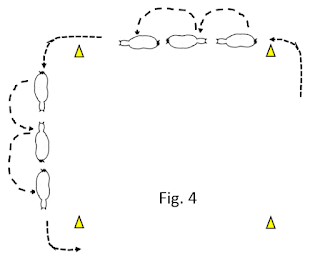Another sickening story of horse abuse as authorities in Texas on Tuesday 10 April 2018 discovered 50 dead horses on a self-described ‘sanctuary’ in Canton, Texas, and seized custody of 87 allegedly mistreated animals. “It was just a sea of dead horses,” Victoria Albrecht, a spokeswoman for the Society for the Prevention of Cruelty to Animals, told the Fort Worth Star-Telegram. “It was just heartbreaking.”
The allegedly mistreated animals included 70 horses, nine donkeys, six pigs and one longhorn, authorities said. The dead horses were found scattered and decomposing along a creek on the property.
The malnourished horses resorted to eating trees clean of their bark, while the pigs were confined to a single pen without access to food, authorities said. Most of the animals were found roaming the fenced-in property with varying health problems, including overgrown and cracked hooves and open sores.
The agency said it first visited the property on March 3rd, 2018 after receiving a complaint of suspected animal cruelty. Officials then began to work with the owners, educating them on proper animal care and entering into an agreement with them to bring the animals’ conditions up to Texas' health and safety code. Officials didn’t know about the dead horses at that time, the statement said.
SPCA investigators checked on the animals two more times before receiving a second complaint on March 30—this time of more than 50 dead horses on that same property. Police and SPCA officials then worked together to gather evidence and take custody of the animals. A deceased horse was taken so its cause of death could be determined by a necropsy, the statement said. The living animals were examined by a medical staff and will receive care until a custody hearing on April 19.
Shamefully, the owners have not been charged. While I fully understand that some people take in animals with full intent of providing a good, fair life to that animal to a natural death, some people just get in over their heads - their abilities and resources, despite their best intent, are just not up to the task. But there is no excuse for not calling someone for help and continue searching for a solution. But people are people and some are capable of horrendous cruelty. All decent people need to report neglect and abuse; and, law enforcement needs to do their part. Violators should be charged and prosecuted.
Texas Penal Code, Section 42.09 Cruelty to Livestock Animals
(a) A person commits an offense if the person intentionally or knowingly:
(1) tortures a livestock animal;
(2) fails unreasonably to provide necessary food, water, or care for a livestock animal in the person's custody;
(3) abandons unreasonably a livestock animal in the person's custody;
(4) transports or confines a livestock animal in a cruel and unusual manner;
(5) administers poison to a livestock animal, other than cattle, horses, sheep, swine, or goats, belonging to another without legal authority or the owner's effective consent;
(6) causes one livestock animal to fight with another livestock animal or with an animal as defined by Section 42.092 (Cruelty to Non-Livestock Animals);
(7) uses a live livestock animal as a lure in dog race training or in dog coursing on a racetrack;
(8) trips a horse; or
(9) seriously overworks a livestock animal.
(b) In this section:
(1) “Abandon” includes abandoning a livestock animal in the person's custody without making reasonable arrangements for assumption of custody by another person.
(2) “Cruel manner” includes a manner that causes or permits unjustified or unwarranted pain or suffering.
(3) “Custody” includes responsibility for the health, safety, and welfare of a livestock animal subject to the person's care and control, regardless of ownership of the livestock animal.
(4) “Depredation” has the meaning assigned by Section 71.001, Parks and Wildlife Code.
(5) “Livestock animal” means:
(A) cattle, sheep, swine, goats, ratites, or poultry commonly raised for human consumption;
(B) a horse, pony, mule, donkey, or hinny;
(C) native or nonnative hoofstock raised under agriculture practices; or
(D) native or nonnative fowl commonly raised under agricultural practices.
(6) “Necessary food, water, or care” includes food, water, or care provided to the extent required to maintain the livestock animal in a state of good health.
(7) “Torture” includes any act that causes unjustifiable pain or suffering.
(8) “Trip” means to use an object to cause a horse to fall or lose its balance.
(c) An offense under Subsection (a)(2), (3), (4), or (9) is a Class A misdemeanor, except that the offense is a state jail felony if the person has previously been convicted two times under this section, two times under Section 42.092, or one time under this section and one time under Section 42.092. An offense under Subsection (a)(1), (5), (6), (7), or (8) is a state jail felony, except that the offense is a felony of the third degree if the person has previously been convicted two times under this section, two times under Section 42.092, or one time under this section and one time under Section 42.092.
(d) It is a defense to prosecution under Subsection (a)(8) that the actor tripped the horse for the purpose of identifying the ownership of the horse or giving veterinary care to the horse.
(e) It is a defense to prosecution for an offense under this section that the actor was engaged in bona fide experimentation for scientific research.
(f) It is an exception to the application of this section that the conduct engaged in by the actor is a generally accepted and otherwise lawful:
(1) form of conduct occurring solely for the purpose of or in support of:
(A) fishing, hunting, or trapping; or
(B) wildlife management, wildlife or depredation control, or shooting preserve practices as regulated by state and federal law; or
(2) animal husbandry or agriculture practice involving livestock animals.
(g) This section does not create a civil cause of action for damages or enforcement of this section.
Article from Fox News















































